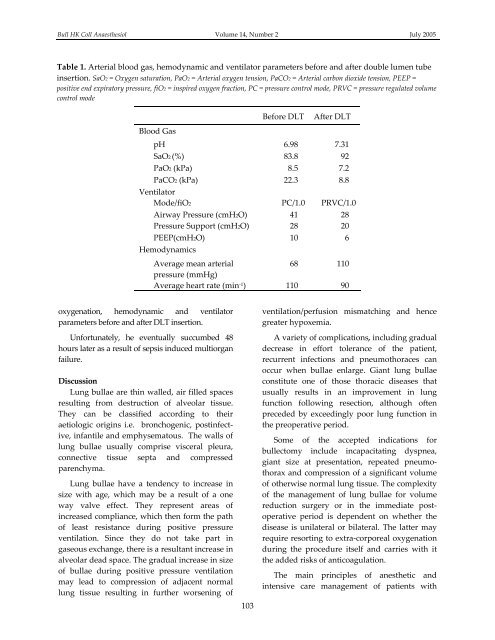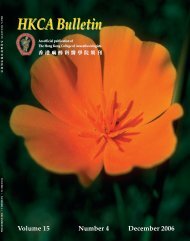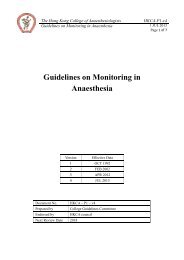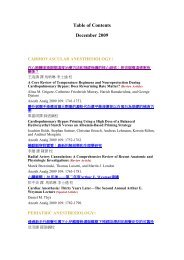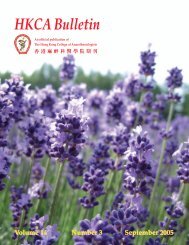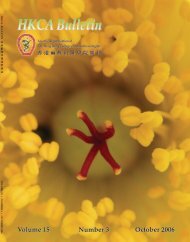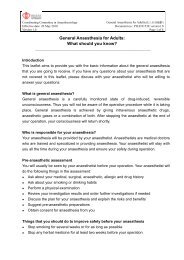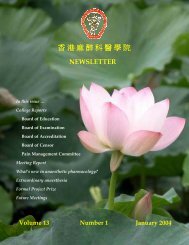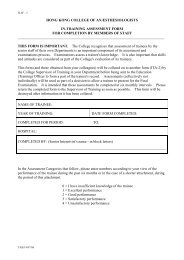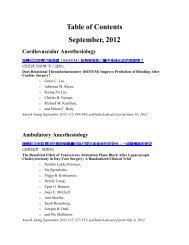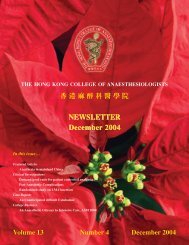July 2005 - The Hong Kong College of Anaesthesiologists
July 2005 - The Hong Kong College of Anaesthesiologists
July 2005 - The Hong Kong College of Anaesthesiologists
You also want an ePaper? Increase the reach of your titles
YUMPU automatically turns print PDFs into web optimized ePapers that Google loves.
Bull HK Coll Anaesthesiol Volume 14, Number 2 <strong>July</strong> <strong>2005</strong>Table 1. Arterial blood gas, hemodynamic and ventilator parameters before and after double lumen tubeinsertion. SaO2 = Oxygen saturation, PaO2 = Arterial oxygen tension, PaCO2 = Arterial carbon dioxide tension, PEEP =positive end expiratory pressure, fiO2 = inspired oxygen fraction, PC = pressure control mode, PRVC = pressure regulated volumecontrol modeBlood GasBefore DLTAfter DLTpH 6.98 7.31SaO2 (%) 83.8 92PaO2 (kPa) 8.5 7.2PaCO2 (kPa) 22.3 8.8VentilatorMode/fiO2 PC/1.0 PRVC/1.0Airway Pressure (cmH2O) 41 28Pressure Support (cmH2O) 28 20PEEP(cmH2O) 10 6HemodynamicsAverage mean arterial68 110pressure (mmHg)Average heart rate (min ‐1 ) 110 90oxygenation, hemodynamic and ventilatorparameters before and after DLT insertion.Unfortunately, he eventually succumbed 48hours later as a result <strong>of</strong> sepsis induced multiorganfailure.DiscussionLung bullae are thin walled, air filled spacesresulting from destruction <strong>of</strong> alveolar tissue.<strong>The</strong>y can be classified according to theiraetiologic origins i.e. bronchogenic, postinfective,infantile and emphysematous. <strong>The</strong> walls <strong>of</strong>lung bullae usually comprise visceral pleura,connective tissue septa and compressedparenchyma.Lung bullae have a tendency to increase insize with age, which may be a result <strong>of</strong> a oneway valve effect. <strong>The</strong>y represent areas <strong>of</strong>increased compliance, which then form the path<strong>of</strong> least resistance during positive pressureventilation. Since they do not take part ingaseous exchange, there is a resultant increase inalveolar dead space. <strong>The</strong> gradual increase in size<strong>of</strong> bullae during positive pressure ventilationmay lead to compression <strong>of</strong> adjacent normallung tissue resulting in further worsening <strong>of</strong>103ventilation/perfusion mismatching and hencegreater hypoxemia.A variety <strong>of</strong> complications, including gradualdecrease in effort tolerance <strong>of</strong> the patient,recurrent infections and pneumothoraces canoccur when bullae enlarge. Giant lung bullaeconstitute one <strong>of</strong> those thoracic diseases thatusually results in an improvement in lungfunction following resection, although <strong>of</strong>tenpreceded by exceedingly poor lung function inthe preoperative period.Some <strong>of</strong> the accepted indications forbullectomy include incapacitating dyspnea,giant size at presentation, repeated pneumothoraxand compression <strong>of</strong> a significant volume<strong>of</strong> otherwise normal lung tissue. <strong>The</strong> complexity<strong>of</strong> the management <strong>of</strong> lung bullae for volumereduction surgery or in the immediate postoperativeperiod is dependent on whether thedisease is unilateral or bilateral. <strong>The</strong> latter mayrequire resorting to extra‐corporeal oxygenationduring the procedure itself and carries with itthe added risks <strong>of</strong> anticoagulation.<strong>The</strong> main principles <strong>of</strong> anesthetic andintensive care management <strong>of</strong> patients with


